Discover 35 hidden attractions, cool sights, and unusual things to do in Baltimore (United States). Don't miss out on these must-see attractions: Walters Art Museum, Baltimore Heritage Walk, and Fort McHenry. Also, be sure to include Baltimore Museum of Art in your itinerary.
Below, you can find the list of the most amazing places you should visit in Baltimore (Maryland).
Table of Contents
Walters Art Museum
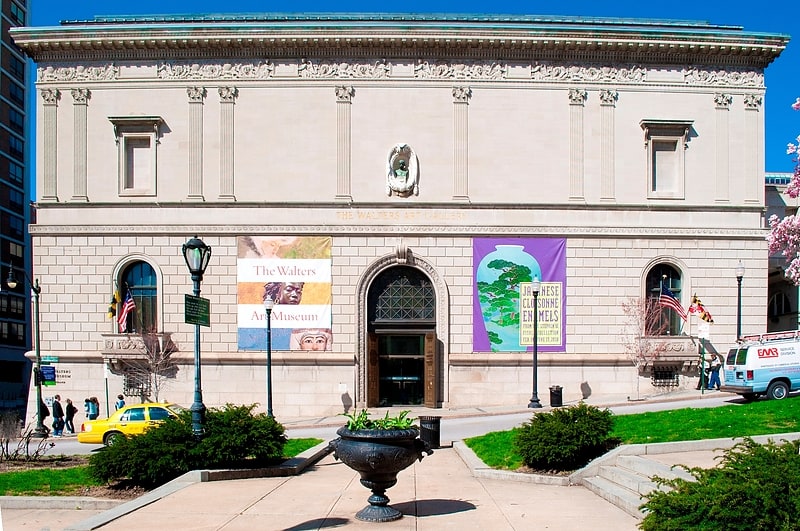
Ancient and 18th-19th century art. The Walters Art Museum, located in Mount Vernon-Belvedere, Baltimore, Maryland, United States, is a public art museum founded and opened in 1934. It holds collections established during the mid-19th century. The Museum's collection was amassed substantially by major American art and sculpture collectors, a father and son: William Thompson Walters, who began collecting when he moved to Paris as a nominal Southern/Confederate sympathizer at the outbreak of the American Civil War in 1861; and Henry Walters, who refined the collection and made arrangements for the construction of a later landmark building to rehouse it. After allowing the Baltimore public to occasionally view his father's and his growing added collections at his West Mount Vernon Place townhouse/mansion during the late 1800s, he arranged for an elaborate stone palazzo-styled structure built for that purpose in 1905–1909. Located across the back alley, a block south of the Walters mansion on West Monument Street/Mount Vernon Place, on the northwest corner of North Charles Street at West Centre Street.
The mansion and gallery were also just south and west of the landmark Washington Monument in the Mount Vernon-Belvedere neighborhood, just north of the downtown business district and northeast of Cathedral Hill. Upon his 1931 death, Henry Walters bequeathed the entire collection of then more than 22,000 works, the original Charles Street Gallery building, and his adjacent townhouse/mansion just across the alley to the north on West Mount Vernon Place to the City of Baltimore, "for the benefit of the public." The collection includes masterworks of ancient Egypt, Greek sculpture and Roman sarcophagi, medieval ivories, illuminated manuscripts, Renaissance bronzes, Old Master European and 19th-century paintings, Chinese ceramics and bronzes, Art Deco jewelry, and ancient Near East, Mesopotamian, or ancient Middle East items.
In 2000, "The Walters Art Gallery" changed its long-time name to "The Walters Art Museum" to reflect its image as a large public institution and eliminate confusion among some of the increasing out-of-state visitors. The following year, "The Walters" reopened its original main building after a dramatic three-year physical renovation and replacement of internal utilities and infrastructure. The Archimedes Palimpsest was on loan to the Walters Art Museum from a private collector for conservation and spectral imaging studies.
Starting on October 1, 2006, the museum was enabled to make admission free to all, year-round, as a result of substantial grants given by Baltimore City and the surrounding suburban Baltimore County arts agencies and authorities. In 2012, "The Walters" released nearly 20,000 of its own images of its collections on a Creative Commons license, and collaborated in their upload to the world-wide web and the Internet on Wikimedia Commons. This was one of the largest and most comprehensive such releases made by any museum.[1]
Address: 600 N Charles St, 21201 Baltimore (Central Baltimore)
Baltimore Heritage Walk
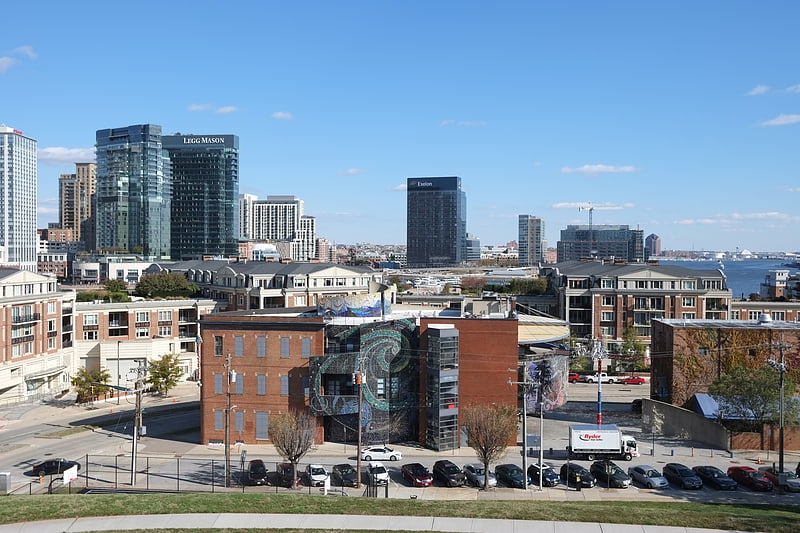
The Baltimore City Heritage Walk is a heritage trail that links 20 historic sites and museums in downtown Baltimore, Maryland.
It is 3.2 miles long.
Sites and museums located along the trail include:
- U.S.S. Constellation Museum, Pier 1, (Constellation Dock), East Pratt Street, at South Calvert Street
- World Trade Center / Top of the World observation deck, (Maryland Port Administration), Pier 2, 401 East Pratt Street
- Baltimore Maritime Museum, (Historic Ships in Baltimore), Pier 3 (and Piers 4 & 5), 500 block - East Pratt Street
- Baltimore Public Works Museum, (old Eastern Avenue Sewage Pumping Station), 751 Eastern Avenue, at President Street boulevard.
- President Street Station, (Baltimore Civil War Museum), 601 President Street, at Fleet Street
- Star-Spangled Banner Flag House, and War of 1812 Museum, (home of Mary Pickersgill), 844 East Pratt Street at Albemarle Street
- Reginald F. Lewis Museum of Maryland African-American History & Culture, 830 East Pratt Street (at President Street boulevard)
- Carroll Mansion, (city townhouse/mansion of Charles Carroll of Carrollton), East Lombard Street, off Front Street / President Street boulevard
- Jewish Museum of Maryland, (Lloyd Street Synagogue and B'nai Israel Synagogue), Lloyd Street at Watson Street (off East Lombard Street)
- McKim Free School, 1120 East Baltimore Street at Asquith Street
- Old Town Friends' Meetinghouse, 1201 East Fayette Street, at Asquith Street
- Nine North Front Street (Second Mayor Thorowgood Smith's Home / Women's Civic League offices)
- Phoenix Shot Tower, East Fayette and North Front Streets
- St. Vincent de Paul Roman Catholic Church, 120 North Front Street (at East Fayette Street)
- War Memorial Plaza (War Memorial Hall), 100 block North Gay Streets, between East Fayette and Lexington Streets
- Zion Church of the City of Baltimore, (Evangelical Lutheran), 400 East Lexington Street at North Gay Street
- Peale Museum, (old Municipal Museum - now conference center), 225 North Holliday Street
- Baltimore City Hall, 100 Holliday Street (between East Fayette and Lexington Streets)
- Battle Monument, (War of 1812 / Battle of Baltimore, 1814), 100 block North Calvert Street, between East Fayette and East Lexington Streets
- Alex. Brown Building, 135 East Baltimore Street, at South Calvert Street
Address: 401 Light Street, 21202-1014 Baltimore (Central Baltimore)
Fort McHenry
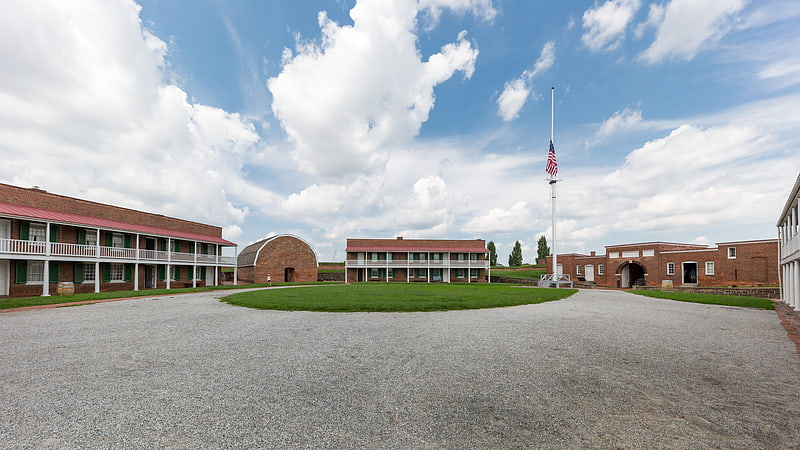
National park in Baltimore, Maryland. Fort McHenry is a historical American coastal pentagonal bastion fort on Locust Point, now a neighborhood of Baltimore, Maryland. It is best known for its role in the War of 1812, when it successfully defended Baltimore Harbor from an attack by the British navy from the Chesapeake Bay on September 13–14, 1814. It was first built in 1798 and was used continuously by the U.S. armed forces through World War I and by the Coast Guard in World War II. It was designated a national park in 1925, and in 1939 was redesignated a "National Monument and Historic Shrine".
During the War of 1812 an American storm flag, 17 by 25 feet (5.2 m × 7.6 m), was flown over Fort McHenry during the bombardment. It was replaced early on the morning of September 14, 1814 with a larger American garrison flag, 30 by 42 feet (9.1 m × 12.8 m). The larger flag signaled American victory over the British in the Battle of Baltimore. The sight of the ensign inspired Francis Scott Key to write the poem "Defence of Fort M'Henry" that was later set to the tune "To Anacreon in Heaven" and became known as "The Star-Spangled Banner", the national anthem of the United States.[3]
Address: 2400 E Fort Ave, 21230-5390 Baltimore (Southern Baltimore)
Baltimore Museum of Art
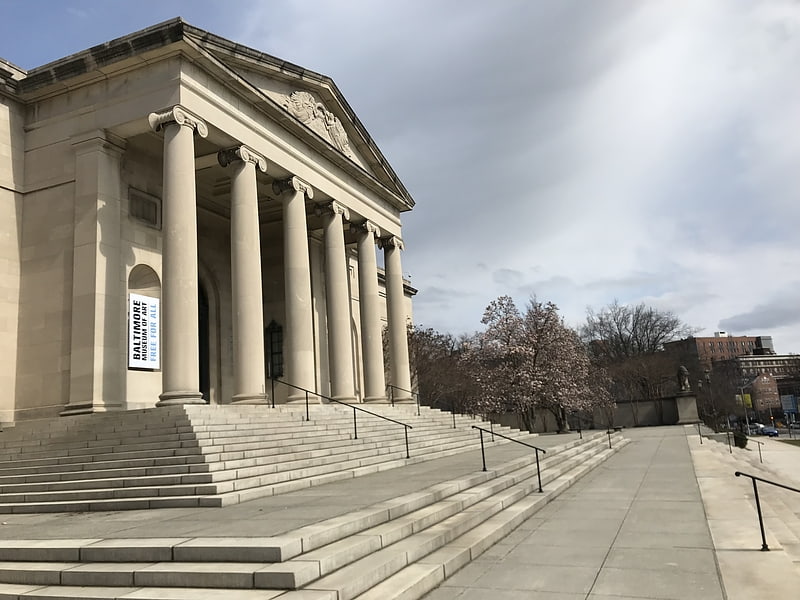
19th-century, modern and contemporary art. The Baltimore Museum of Art in Baltimore, Maryland, United States, is an art museum that was founded in 1914. The BMA's internationally renowned collection of 95,000 objects encompasses more than 1,000 works by Henri Matisse anchored by the Cone Collection of modern art, as well as one of the nation's finest holdings of prints, drawings, and photographs. The galleries currently showcase collections of art from Africa; works by established and emerging contemporary artists; European and American paintings, sculpture, and decorative arts; ancient Antioch mosaics; art from Asia, and textiles from around the world.
The 210,000-square-foot (20,000 m2) museum is distinguished by a neoclassical building designed in the 1920s by renowned American architect John Russell Pope and two landscaped gardens with 20th-century sculpture. The museum is located between Charles Village, to the east, Remington, to the south, Hampden, to the west; and south of the Roland Park neighborhoods, immediately adjacent to the Homewood campus of Johns Hopkins University, though the museum is an independent institution and not affiliated with the university.
The highlight of the museum is the Cone Collection, brought together by Baltimore sisters Claribel (1864–1929) and Etta Cone (1870–1949). Accomplished collectors, the sisters amassed a wealth of works by artists including Henri Matisse, Pablo Picasso, Paul Cézanne, Edgar Degas, Paul Gauguin, Vincent van Gogh, and Pierre-Auguste Renoir, nearly all of which were donated to the museum. The museum is also home to 18,000 works of French mid-19th-century art from the George A. Lucas collection, which has been acclaimed by the museum as a cultural "treasure" and "among the greatest single holdings of French art in the country."
The BMA is currently led by Director Christopher Bedford, who was appointed in May 2016, after a year-long search. Prior to joining the BMA, Bedford led the Rose Art Museum at Brandeis University in Massachusetts for four years. He helped the Rose Art Museum out of the international controversy from 2009, when the university proposed selling off the museum's top-notch art collection to help with its struggling finances.
Since October 2006, The Baltimore Museum of Art and the Walters Art Museum (formerly Walters Art Gallery), have offered free general admission year-round as a result of grants given by Baltimore City, Baltimore County, and several foundations. The museum is also the site of "Gertrude's Chesapeake Kitchen", a popular restaurant owned and operated by chef John Shields.[4]
Address: 10 Art Museum Dr, 21218-3898 Baltimore (Northern Baltimore)
National Aquarium
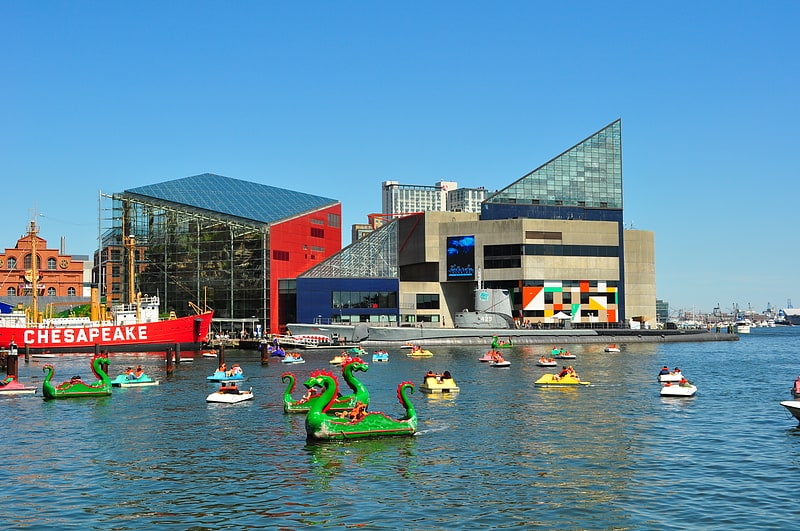
Iconic fixture for marine-life exhibits. The National Aquarium – also known as National Aquarium in Baltimore and formerly known as Baltimore Aquarium – is a non-profit public aquarium located at 501 East Pratt Street on Pier 3 in the Inner Harbor area of downtown Baltimore, Maryland, in the United States. Constructed during a period of urban renewal in Baltimore, the aquarium opened on August 8, 1981. The aquarium has an annual attendance of 1.5 million visitors and is the largest tourism attraction in the State of Maryland. The aquarium holds more than 2,200,000 US gallons of water, and has more than 17,000 specimens representing over 750 species. The National Aquarium's mission is to inspire conservation of the world's aquatic treasures. The aquarium's stated vision is to confront pressing issues facing global aquatic habitats through pioneering science, conservation, and educational programming.
The National Aquarium houses several exhibits including the Upland Tropical Rain Forest, a multiple-story Atlantic Coral Reef, an open ocean shark tank, and Australia: Wild Extremes, which won the "Best Exhibit" award from the Association of Zoos and Aquariums in 2008. The aquarium also has a 4D Immersion Theater. The aquarium opened a marine mammal pavilion on the adjacent south end of Pier 4 in 1990, and currently holds six Atlantic bottlenose dolphins. Of the six, five were born at the National Aquarium, one was born at another American aquarium.
In 2003, the National Aquarium and the much older and independent National Aquarium in Washington, D.C., formed an alliance to operate as a single National Aquarium with two sites. This arrangement continued until 2013, when the Washington location closed permanently.[5]
Address: 501 E Pratt St, 21202 Baltimore (Central Baltimore)
Royal Farms Arena
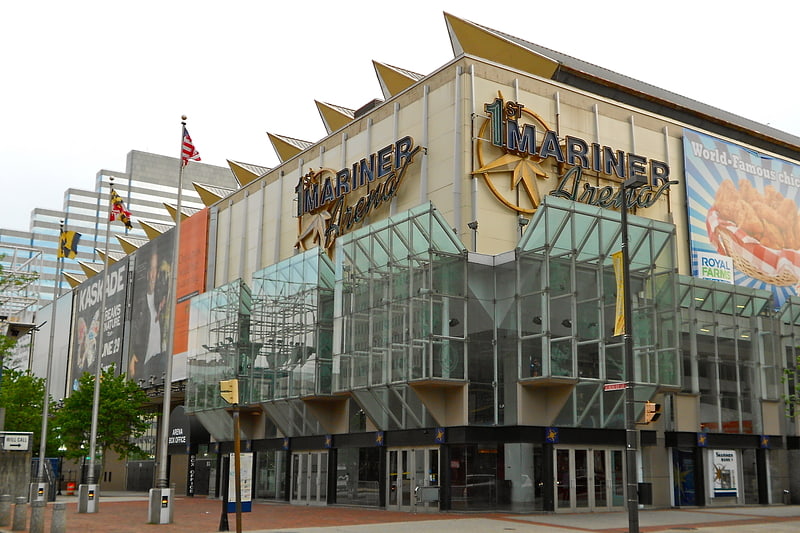
Arena in Baltimore, Maryland. Royal Farms Arena is an arena located in Baltimore. The Arena is located about a block away from the Baltimore Convention Center on the corner of Baltimore Street and Hopkins Place; it is also only a short distance from the Inner Harbor. It seats 11,100 and can be expanded up to 14,000, depending upon the event. The Arena is owned by the city of Baltimore and is currently managed by ASM Global, a private management company.
The Arena officially opened October 23, 1962. Designed by AG Odell Jr. and Associates, it was built on the site of Old Congress Hall, where the Continental Congress met in 1776. As a cornerstone for the Inner Harbor redevelopment during the 1980s, it was reopened after renovations and was renamed the Baltimore Arena in 1986. In 2003, it was renamed for 1st Mariner Bank, which purchased naming rights to the arena for 10 years. It was reported that 1st Mariner Bank paid the city $75,000 a year to keep the naming rights to the complex. When this naming rights agreement ended in 2013, the arena was briefly returned to its "Baltimore Arena" name, until convenience store chain Royal Farms purchased the naming rights in September 2014. This deal calls for Royal Farms to pay $250,000 annually for five years to the city, and gives Royal Farms first rights to renew or restructure their deal at the end of the contract, or in the event that the city constructs a new arena.
A cornerstone to the Arena was laid in 1961 with a vault that included messages from then-U.S. President John F. Kennedy, then-Maryland governor J. Millard Tawes, and then-Baltimore Mayor J. Harold Grady. The vault was opened in 2006.
The current site that was chosen for the Baltimore Civic Center was actually not one of the many sites proposed to the Greater Baltimore Committee in 1955. Among nine suggested locations were two in Druid Hill Park, three at the end of the Inner Harbor basin (where the World Trade Center and Harborplace are now located), and one in Clifton Park.[6]
Address: Baltimore, 201 West Baltimore Street
Maryland Science Center
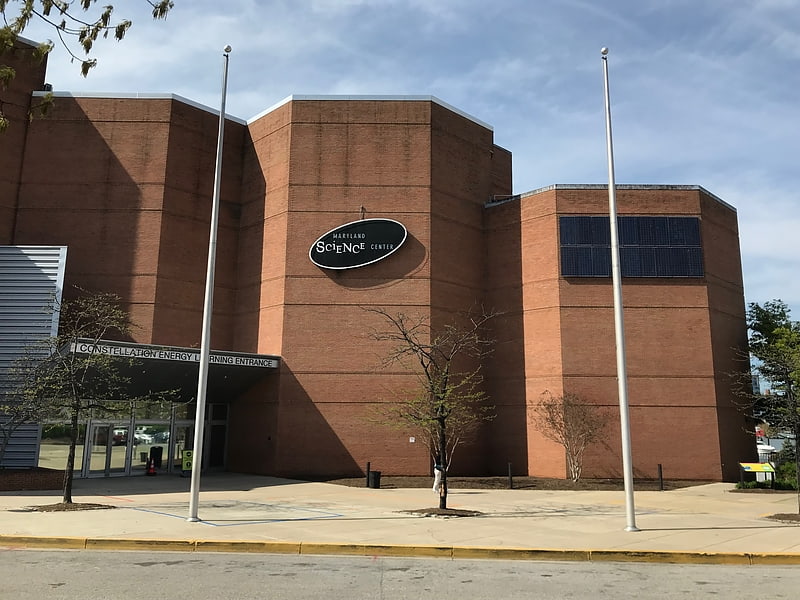
The Maryland Science Center, located in Baltimore's Inner Harbor, opened to the public in 1976. It includes three levels of exhibits, a planetarium, and an observatory. It was one of the original structures that drove the revitalization of the Baltimore Inner Harbor from its industrial roots to a thriving downtown destination. In 1987, an IMAX theater was added, but the museum continued to show its age as the end of the 20th century approached. In 2004, a large addition to the property was opened, and the modernized hands-on exhibits now include more than two dozen dinosaur skeletons. Subjects that the center displays include physical science, space, Earth science, the human body, and blue crabs that are native to the Chesapeake Bay.
Maryland Science Center won a 2006 Best of Baltimore award for "Best Place to Take Kids." In 2008 the Maryland Science Center was named one of the “10-Best Science Centers for Families” by Parent's magazine.[7]
Address: 601 Light St, 21230 Baltimore (Central Baltimore)
The Maryland Zoo in Baltimore
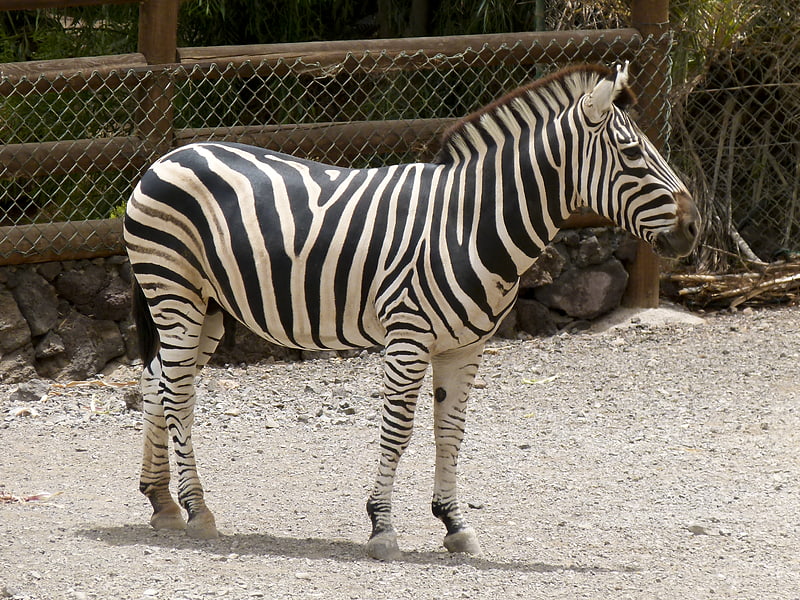
Zoo in Baltimore, Maryland. The Maryland Zoo — also known as The Maryland Zoo in Baltimore and formerly known as The Baltimore City Zoo or the Baltimore Zoo — is a 135-acre park located in historic Druid Hill Park in the northwestern area of the City of Baltimore, Maryland, with the postal address of 1876 Mansion House Drive. Druid Hill was opened in 1876 as the first major park purchase by the City under foreseeing Mayor Thomas Swann, and was later designed by famed nationally-known landscaper Frederick Law Olmsted, with additional work on various park buildings contributed by future Baltimore City Hall architect George A. Frederick, and Park Commissioner John H.B. Latrobe, who also was an accomplished lawyer, author, artist, amateur architect and civic leader. Olmsted had earlier won a contest for the design of plans for New York City's famed Central Park in mid-town Manhattan in 1858, a year after it opened, and worked on the massive public works project during its construction from 1858 to 1873. The Maryland Zoo is now currently home to over 2,000 animals, and is accredited by the Association of Zoos and Aquariums.[8]
Address: 1 Safari Pl, 21217 Baltimore (Northern Baltimore)
American Visionary Art Museum
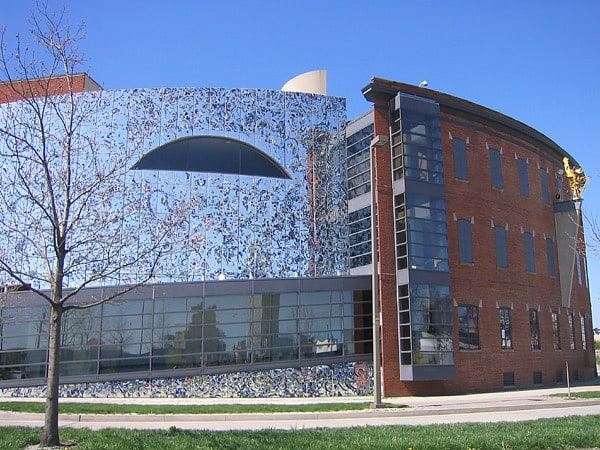
Museum in Baltimore, Maryland. The American Visionary Art Museum is an art museum located in Baltimore, Maryland's Federal Hill neighborhood at 800 Key Highway. The museum specializes in the preservation and display of outsider art. The city agreed to give the museum a piece of land on the south shore of the Inner Harbor under the condition that its organizers would clean up residual pollution from a copper paint factory and a whiskey warehouse that formerly occupied the site. It has been designated by Congress as America's national museum for visionary art.
AVAM's 1.1 acre campus contains 67,000 square feet of exhibition space and a permanent collection of approximately 4,000 pieces. The permanent collection includes works by visionary artists like Ho Baron, Nek Chand, Howard Finster, Vanessa German, Mr. Imagination, Leonard Knight, William Kurelek, Leo Sewell, Judith Scott, Ben Wilson, as well as over 40 pieces from the Cabaret Mechanical Theatre of London. AVAM artists, the museum boasts, include “farmers, housewives, mechanics, the disabled, the homeless.. all inspired by the fire within.” The museum's Main Building features three floors of exhibition space, and the campus includes a Tall Sculpture Barn and Wildflower Garden, along with large exhibition and event spaces in the Jim Rouse Visionary Center.
The museum has no staff curators, preferring to use guest curators for its shows. Rather than focusing shows on specific artists or styles, it sponsors themed exhibitions with titles such as Wind in Your Hair and High on Life. The museum's founder, Rebecca Alban Hoffberger, takes pride in the fact that AVAM is "pretty un-museumy".[9]
Address: 800 Key Hwy, 21230 Baltimore (Southern Baltimore)
Federal Hill Park

Park in Baltimore, Maryland. Federal Hill Park is a 10.3 acres park located in Baltimore, Maryland on the south shore of the Inner Harbor. The park is a signature Baltimore landmark and offers visitors some of the most noted views in the city often photographed looking north to the downtown skyline of skyscrapers across the Inner Harbor of the Northwest Branch of the Patapsco River / Baltimore Harbor. The Federal Hill surrounding neighborhood to the west and south is named for the prominent hill and is also known as old South Baltimore. The now graded grass lawn hill and park, was originally a jagged cliffs and bluffs of red clay which was mined in the 18th and 19th centuries after being first sighted and described by Captain John Smith of England on his voyages of exploration of the Chesapeake Bay from the first English colony at Jamestown, Virginia in 1608. The noted famous site today is bounded by Francis Scott Key Highway along the waterfront to the north, Battery Avenue to the west, Warren Avenue to the south, and Covington Street to the east. Baltimore city acquired the hill as public property in 1880 after it was used and fortified as a fort with heavy artillery by the Union Army during the American Civil War. It was established then as a city park operated and maintained by the city Department of Recreation and Parks.[10]
Address: 300 Warren Ave, 21230 Baltimore (Southern Baltimore)
Lexington Market
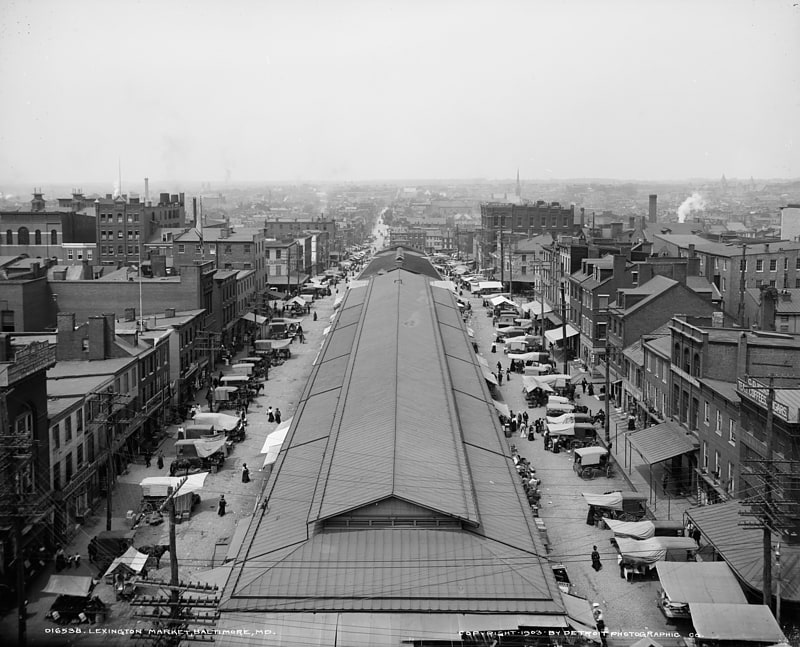
Lexington Market is a historic market in downtown Baltimore, Maryland, United States. The main market is housed in two large buildings on the north corners of the intersection of Paca and Lexington Streets. In the broader sense, Lexington Market encompasses both the main market and all of the shops on Lexington Street from Greene Street to Liberty Street.
The main market buildings are host to small eateries and stands selling fish, produce, meat, baked goods, and candy.
Lexington Market is located near the Baltimore Light Rail and Baltimore Metro Subway stops of the same name. It is about six blocks from Oriole Park at Camden Yards.
Lexington Market is one of the longest-running markets in the world, having been around since 1789. The market continues to stand in its original site. The land for this historical market was donated by General John Eager Howard, famous colonial Revolutionary War commander of Maryland Line regiment of Continental Army. from his estate "Belvedere" (also known as "Howard's Woods) west and north of Baltimore Town. The market originally operated without sheds and stalls. Farmers would load up their horse drawn wagons with ham, butter, eggs and produce. The farmers would travel from Towson and Reisterstown to sell their goods at the market. They would usually start work by dawn.
In 1803 the market had increased in size. The market now spreads from Eutaw Street down to Lexington Street. It would later spread over to Greene Street. In the beginning the market was open on Tuesdays, Friday and Saturday from 2am until 12pm. A bell would ring at the start of the day and at the end of the day. Before being called Lexington Market it was known as Western Precincts Market.
The market remains open as a new market building is under construction. The new market began construction in February 2020 and is set to open in fall 2022, following construction delays and price increases stemming from the COVID-19 pandemic.[11]
Address: 400 West Lexington Street, Baltimore (Central Baltimore)
War Memorial Plaza
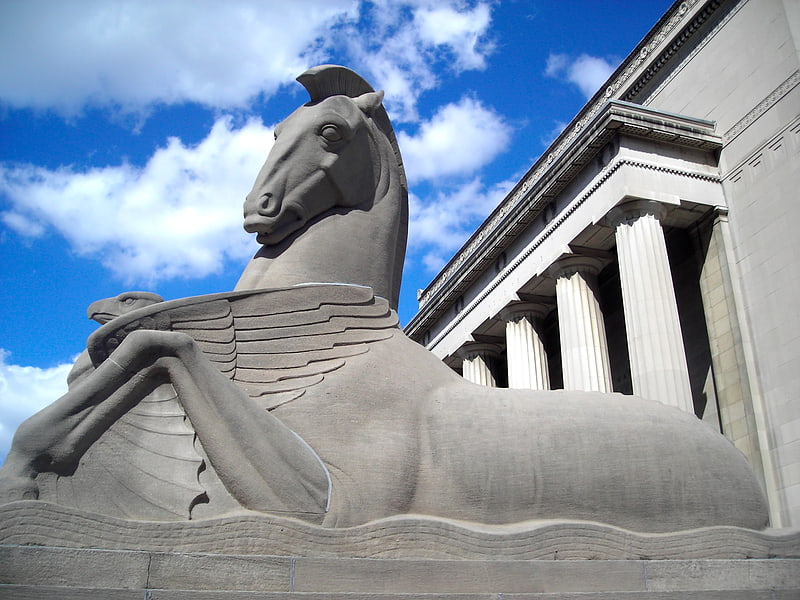
War Memorial Plaza is a public square, small park and space in Downtown Baltimore between City Hall and the War Memorial Building, between Holliday Street on the west, East Fayette Street on the south, North Gay Street on the east, and East Lexington Street on the north.[12]
Fell's Point
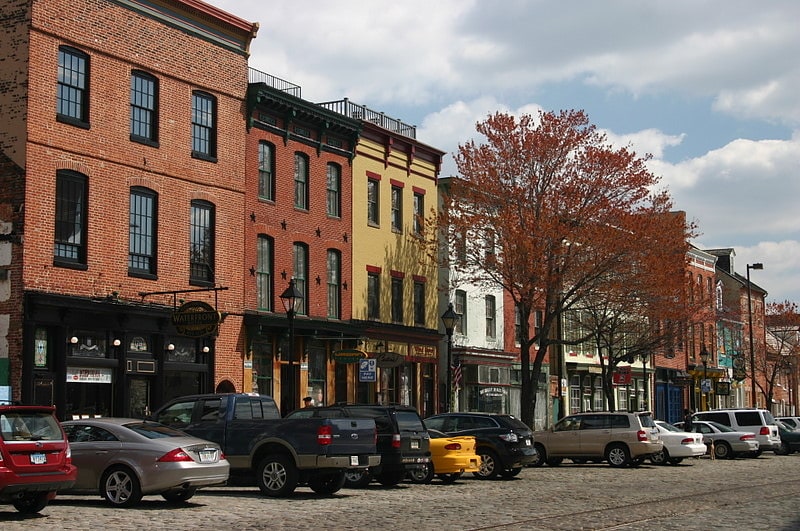
Neighborhood in Baltimore, Maryland. Fell's Point is a historic waterfront neighborhood in southeastern Baltimore, Maryland, United States. It was established around 1763 and is located along the north shore of the Baltimore Harbor and the Northwest Branch of the Patapsco River. The area has many antique, music and other stores, restaurants, coffee bars, a municipal markethouse with individual stalls, and over 120 pubs. Located 1.5 miles east of Baltimore's downtown central business district and the Jones Falls stream, Fells Point has a maritime past and the air of a seafaring town. It also has the greatest concentration of drinking establishments and restaurants in the city.
The neighborhood has also been historically the home of large immigrant populations of Irish, Germans, Jews, Poles and other Eastern European nationalities such as Ukrainians, Russians, Czechs, and Slovaks, throughout its 250-year-old history. Since the 1970s, a steadily increasing number of middle- to upper-middle-income residents has moved into the area, restoring and preserving historic homes and businesses. Upper Fell's Point to the north along Broadway has gained a sizable Latino population, primarily from waves of Mexican and Central American immigrants since the 1980s, and is sometimes now called "Spanish Town".
This Fells Point waterfront is an upscale residential area and tourist destination featuring first rate hotels and restaurants. It can be reached by water taxi barges, on foot as it is a very short walk form the Inner Harbor, and by bus or car. Fells Point is one of several areas in and around Baltimore that are listed on the National Register of Historic Places, (maintained by the National Park Service), the first designated from Maryland, and is one of the first registered historic districts in the United States to combine two separate waterfront communities (along with Federal Hill to the southwest across the Patapsco River and the Harbor on the "Old South Baltimore" peninsula of "Whetstone Point" at Fort McHenry).[13]
Seven Foot Knoll Light
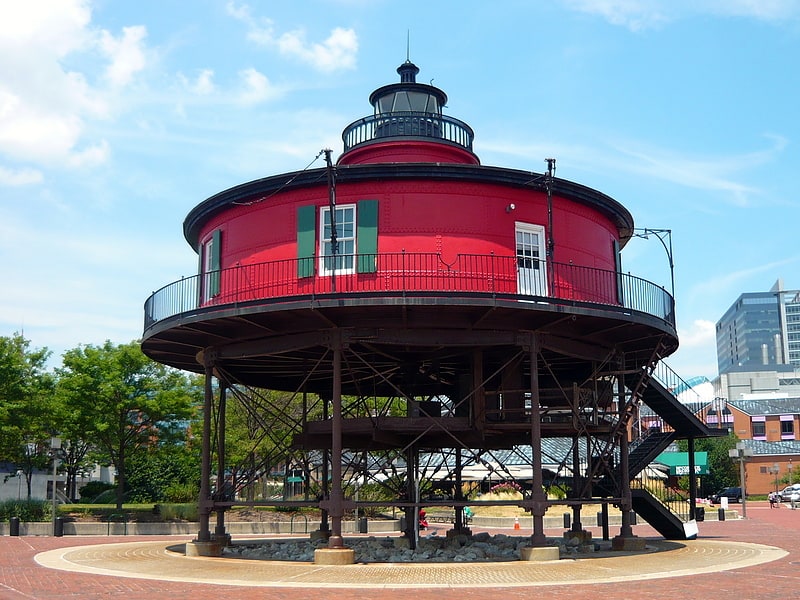
Lighthouse. The Seven Foot Knoll Light was built in 1855 and is the oldest screw-pile lighthouse in Maryland. It was located atop Seven Foot Knoll in the Chesapeake Bay until it was replaced by a modern navigational aid and relocated to Baltimore's Inner Harbor as a museum exhibit.[14]
Address: 301 E Pratt St, 21202 Baltimore (Central Baltimore)
Inner Harbor

The Inner Harbor is a historic seaport, tourist attraction, and landmark of the city of Baltimore, Maryland. It was described by the Urban Land Institute in 2009 as "the model for post-industrial waterfront redevelopment around the world". The Inner Harbor is located at the mouth of Jones Falls, creating the wide and short northwest branch of the Patapsco River. The district includes any water west of a line drawn between the foot of President Street and the American Visionary Art Museum.
The name "Inner Harbor" is used not just for the water but for the surrounding area of the city, with approximate street boundaries of President Street to the east, Lombard Street to the north, Greene Street to the west, and Key Highway on the south. The harbor is within walking distance of Camden Yards and M&T Bank Stadium. A water taxi connects passengers to Fells Point, Canton, and Fort McHenry.[15]
Address: 201 East Pratt St, Baltimore
Washington Monument
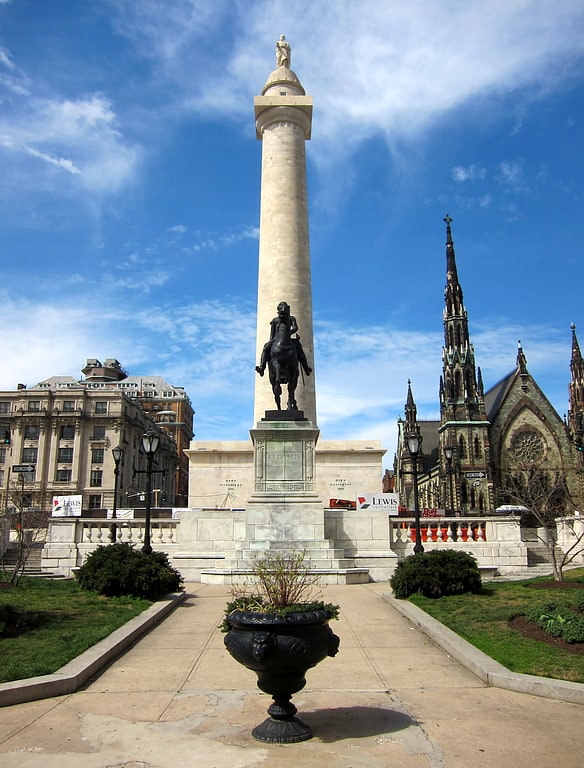
The Washington Monument is the centerpiece of intersecting Mount Vernon Place and Washington Place, an urban square in the Mount Vernon-Belvedere neighborhood north of downtown Baltimore, Maryland. It was the first major monument begun to honor George Washington.[16]
Address: 699 North Charles Street, 21201 Baltimore (Central Baltimore)
Harborplace
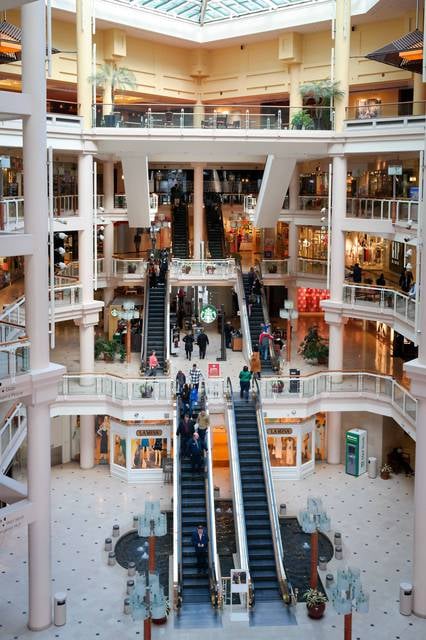
Shopping complex in Baltimore, Maryland. Harborplace is a shopping complex on the Inner Harbor in Baltimore, Maryland.[17]
Address: Baltimore, 201 East Pratt Street, 301 Light Street
Lake Montebello

Reservoir in Maryland. Lake Montebello is a reservoir located near Mayfield and Coldstream-Homestead-Montebello in Northeast Baltimore City in central Maryland. The lake was excavated and constructed in 1881, and nearby Montebello Filtration Plants 1 and 2 were completed in 1915 and 1928, respectively. The lake contains approximately 410 million gallons of water, with a maximum storage of 606 million gallons. Today, the lake continues to act as a settling basin for what goes on in the filtration plant. A 1.3 mile bike and walking path lines the lake and are used as a recreational area for the surrounding community.[18]
Address: Curran Dr & Whitman Dr, 21213 Baltimore (Northeastern Baltimore)
Camden Yards Sports Complex
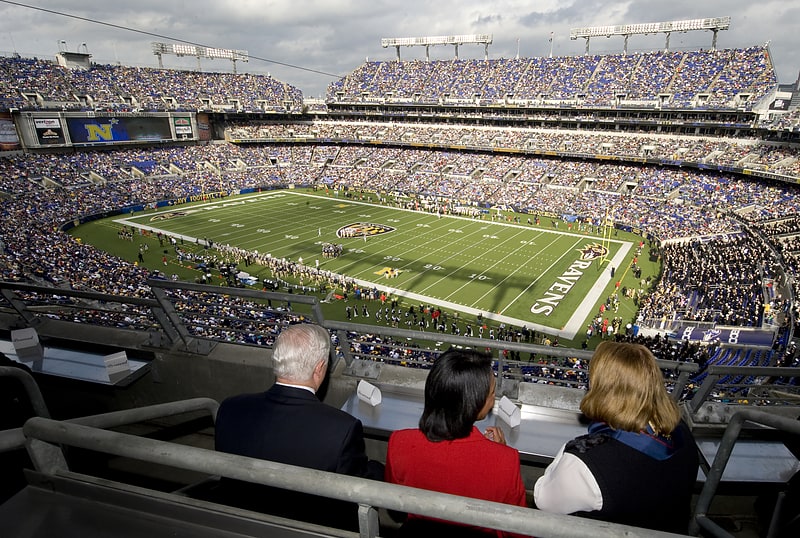
The Camden Yards Sports Complex is located in the center of Baltimore, Maryland. The complex is composed of multiple buildings and stadiums including Oriole Park at Camden Yards and M&T Bank Stadium. The two stadiums are home to the Baltimore Orioles of Major League Baseball and the Baltimore Ravens of the National Football League. The complex still houses the recently closed Sports Legends Museum at Camden Yards. Along with the Sports Legends Museum, the Babe Ruth Birthplace and Museum is located approximately two blocks from the main entrance of Camden Yards at Eutaw Street. Geppi's Entertainment Museum is also located in Camden Station, atop the Sports Legends at Camden Yards. In addition to the sports facilities, it is also a location for community events such as the Dew Tour's Panasonic Open in June 2007 and 2008, the Baltimore Marathon, and the African American Festival which is held every year.[19]
Address: 301 W Camden St, 21201-2434 Baltimore (Southern Baltimore)
Star-Spangled Banner National Historic Trail
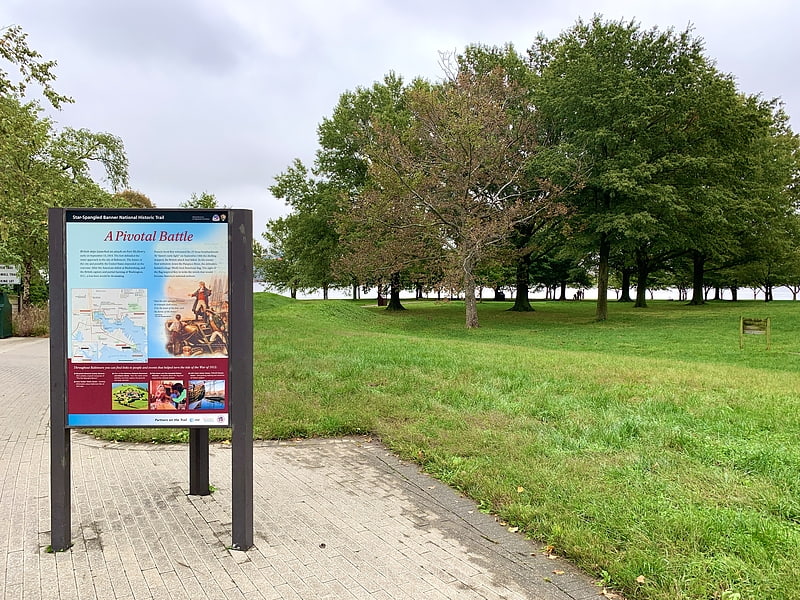
National park in Baltimore, Maryland. The Star-Spangled Banner National Historic Trail is a National Historic Trail that commemorates the Chesapeake Campaign of the War of 1812. The 290-mile trail was named after "The Star-Spangled Banner," the national anthem of the United States. Consisting of water and overland routes, the trail extends from Tangier Island, Virginia, through southern Maryland, the District of Columbia, the Chesapeake Bay, and Baltimore, Maryland. The trail also contains sites on Maryland's Eastern shore.
Activities on the trail include hiking, biking, boating, and geocaching on the Star-Spangled Banner Geotrail. Sites on the trail include towns raided and/or burned by the British, battles and engagements, museums, and forts.
It was authorized by the Consolidated Natural Resources Act of 2008.[20]
USS Torsk

Tench-class submarine. USS Torsk, hull number SS-423, is a Tench-class submarine built for the United States Navy during World War II. Armed with ten torpedo tubes, the Tench-class submarines were incremental developments of the highly-successful Gato-class submarines that formed the backbone of the US Navy's submarine force during the war. Torsk was laid down at the Portsmouth Navy Yard in June 1944, was launched in September that year, and commissioned in December.
In 1945, Torsk made two war patrols off Japan, sinking one cargo vessel and two coastal defense frigates. The latter of these, torpedoed on 14 August 1945, was the last enemy ship sunk by the United States Navy in World War II. Throughout the 1950s and 1960s, she operated primarily as a training vessel; she also went on deployments to the Mediterranean Sea and helped to train elements of the Atlantic Fleet in anti-submarine tactics. Decommissioned in 1964, she served for another seven years as a training vessel for the Naval Reserve. She was stricken from the Naval Vessel Register in December 1971 and turned over to the state of Maryland for use as a museum ship. She is now part of the historic fleet of Historic Ships in Baltimore.[21]
Address: 501 E Pratt St, 21202-3574 Baltimore
Druid Hill Park

Park in Baltimore, Maryland. Druid Hill Park is a 745-acre urban park in northwest Baltimore, Maryland. Its boundaries are marked by Druid Park Drive, Swann Drive and Reisterstown Road, and the Jones Falls Expressway / Interstate 83.
Inaugurated in 1860, under the administration of city Mayor Thomas Swann, Druid Hill Park ranks with Central Park (begun in 1858) in New York City, Fairmount Park (1812) in Philadelphia and Golden Gate Park in San Francisco as the oldest landscaped public parks in the United States.[22]
Chesapeake
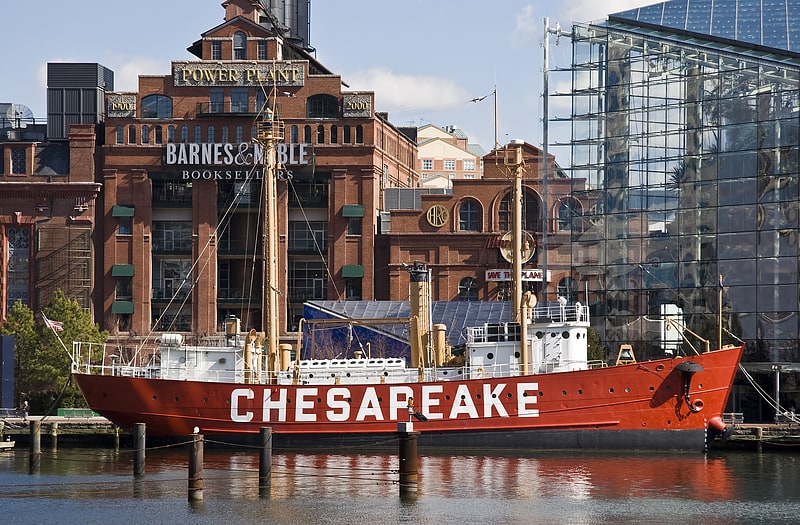
Ship. United States lightship Chesapeake is a museum ship owned by the National Park Service and on a 25-year loan to Baltimore City, and is operated by Historic Ships in Baltimore Museum in Baltimore, Maryland. A National Historic Landmark, she is one of a small number of preserved lightships. Since 1820, several lightships have served at the Chesapeake lightship station and have been called Chesapeake. Lightships were initially lettered in the early 1800s, but then numbered as they were often moved from one light station to another. The name painted on the side of lightships was the short name of the Light Station they were assigned to and was the day time visual aspect of the many Aids to Navigation on board lightships. The United States Coast Guard assigned new hull numbers to all lightships still in service in April 1950. After that date, Light Ship 116 was then known by the new Coast Guard Hull number: WAL-538. In January 1965 the Coast Guard further modified all lightship hull designations from WAL to WLV, so Chesapeake became WLV-538.
Chesapeake had many redundant systems in order to maintain her position through most storms. The 5,000 pounds (2,300 kg) main anchor was backed up by a second 5000-pound anchor attached to the side of the ship. The 30,000 candela main light was also backed up with a secondary lamp and the Radio Locator Beacon also had a backup system. On more than one occasion (in 1933, 1936, and 1962) the main anchor chain snapped during violent storms and the ship had to use her engines to stay in place and drop her second anchor.[23]
Address: Pier 3, 21202 Baltimore
Edgar Allan Poe House and Museum
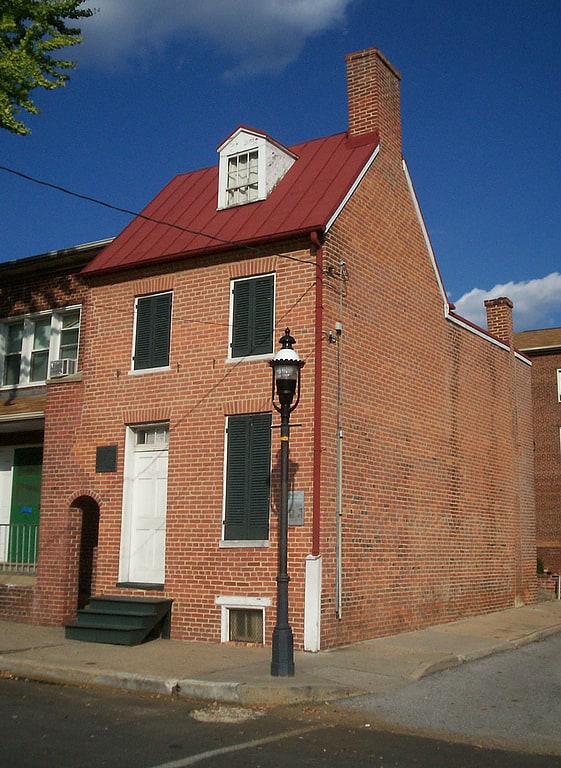
Preserved historic site with exhibits. The Edgar Allan Poe House and Museum, located at 203 North Amity St. in Baltimore, Maryland, is the former home of American writer Edgar Allan Poe in the 1830s. The small unassuming structure, which was opened as a writer's house museum in 1949, is a typical row home. It was designated a National Historic Landmark in 1972.
Due to a loss of funding by the city of Baltimore, the Museum closed to the public in October 2012. Poe Baltimore, the Museum's new governing body, reopened the museum to the public on October 5, 2013. The house is the site for the International Edgar Allan Poe Festival & Awards, held in October of each year.[24]
Address: 203 N Amity St, 21223 Baltimore (Western Baltimore)
Flag House & Star-Spangled Banner Museum

The Star-Spangled Banner Flag House, formerly the Flag House & Star-Spangled Banner Museum, is a museum located in the Jonestown/Old Town and adjacent to Little Italy neighborhoods of eastern downtown Baltimore, Maryland, United States.
Built in 1793, it was the home of Mary Young Pickersgill when she moved to Baltimore in 1806 and the location where she later sewed the "Star Spangled Banner," in 1813, the huge out-sized garrison flag that flew over Fort McHenry at Whetstone Point in Baltimore Harbor in the summer of 1814 during the British Royal Navy attack in the Battle of Baltimore during the War of 1812. The museum contains furniture and antiques from the Federal period as well as items from the Pickersgill family.
A supplemental 12,600-square-foot (1,170 m2) museum was constructed to the rear next to Pickersgill's home. This museum houses exhibits on the War of 1812 and the Battle of Baltimore. It has an orientation theater, gift shop, exhibit galleries, and meeting rooms. The museum features a 30 by 42-foot (13 m) tall window which was created to be the same color, size, and design of the original "Star-Spangled Banner" flag of 15 stars and 15 stripes made by Pickersgill in the adjacent Flag House and completed on the floor of a nearby brewery by members of her family and servants/slaves. Set into the ground outside the museum is a map of the United States, with each state formed from a piece of stone quarried within its borders.[25]
Address: 844 E Pratt St, 21202-4403 Baltimore (Southeastern Baltimore)
Green Mount Cemetery
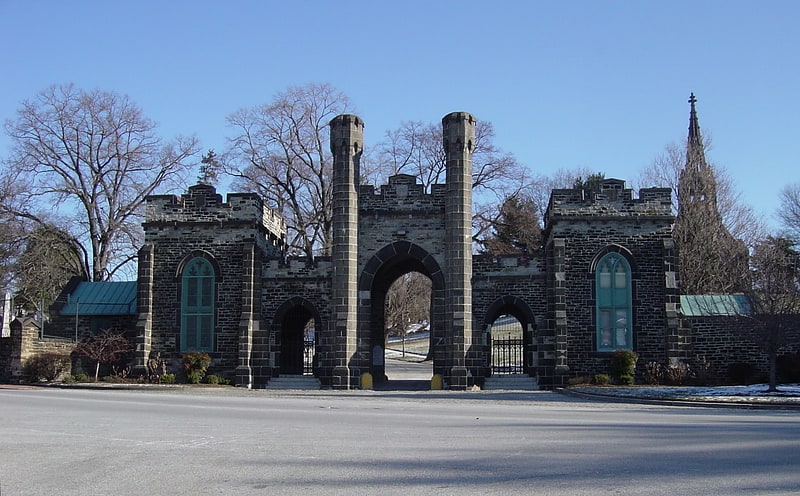
Cemetery in Baltimore, Maryland. Green Mount Cemetery is a historic rural cemetery in Baltimore, Maryland, United States. Established on March 15, 1838, and dedicated on July 13, 1839, it is noted for the large number of historical figures interred in its grounds as well as many prominent Baltimore-area families. It retained the name Green Mount when the land was purchased from the heirs of Baltimore merchant Robert Oliver. Green Mount is a treasury of precious works of art, including striking works by major sculptors including William H. Rinehart and Hans Schuler.
The cemetery was listed in the National Register of Historic Places in 1980. Guided tours are available at various times of the year.
A Baltimore City Landmark plaque at the entrance reads:
Green Mount Cemetery was dedicated in 1839 on the site of the former country estate of Robert Oliver. This was at the beginning of the "rural cemetery movement"; Green Mount was Baltimore's first such rural cemetery and one of the first in the U.S. The movement began both as a response to the health hazard posed by overcrowded church graveyards, and as part of the larger Romantic movement of the mid-1800s, which glorified nature and appealed to emotions.
Green Mount reflects the romanticism of its age, not only by its very existence, but also by its buildings and sculpture. The gateway, designed by Robert Cary Long, Jr. and the hilltop chapel, designed by J. Rudolph Niernsee and J. Crawford Neilson, are Gothic Revival, a romantic style recalling medieval buildings remote in time.
Nearly 65,000 people are buried here, including the poet Sydney Lanier, philanthropists Johns Hopkins and Enoch Pratt, Napoleon Bonaparte's sister-in-law Betsy Patterson, John Wilkes Booth, and numerous military, political and business leaders.
In addition to John Wilkes Booth, two other conspirators in the assassination of Abraham Lincoln are buried here, Samuel Arnold and Michael O'Laughlen. It is common for visitors to the cemetery to leave pennies on the graves of the three men; the one-cent coin features the likeness of the president they successfully sought to murder.
The abdicated King Edward VIII and his wife, the Duchess of Windsor, had planned for a burial in a purchased plot in Rose Circle at Green Mount Cemetery, near where the father of the Duchess was interred. However, in 1965 an agreement with Queen Elizabeth II allowed for the king and duchess to be buried near other members of the royal family in the Royal Burial Ground near Windsor Castle.[26]
Address: 1501 Greenmount Ave, 21202 Baltimore (Northern Baltimore)
Little Italy
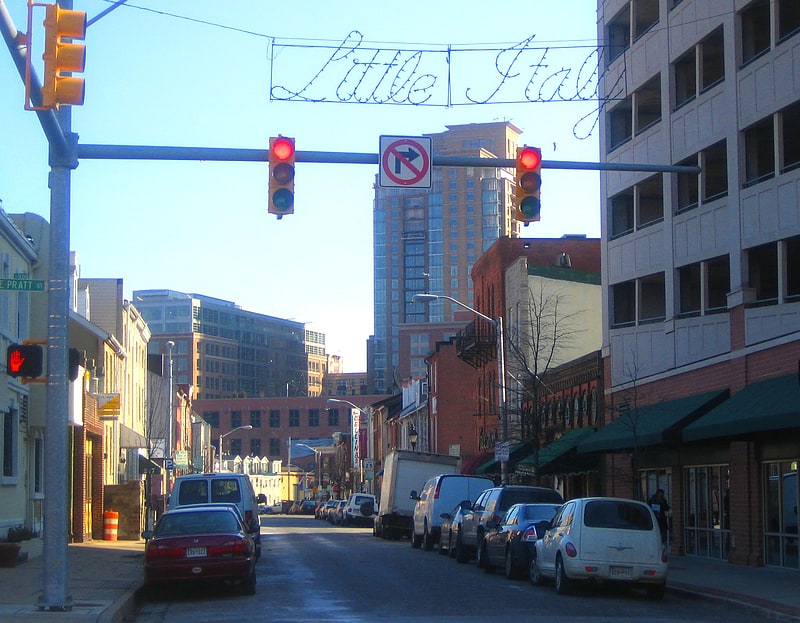
Neighborhood in Baltimore, Maryland. Little Italy is a neighborhood located in southeastern Baltimore, Maryland. The neighborhood is known for its strong Italian-American heritage and identity. The neighborhood is still mostly populated by the descendants of Italian-American immigrants and remains a closely knit ethnic enclave.
Due to its close proximity to desirable neighborhoods such as Fell's Point, Upper Fell's Point and Harbor East, real estate values in Little Italy have become high in recent years. Another cause for the neighborhood's competitive real estate market is the lack of properties entering the market due to the longstanding neighborhood tradition of keeping houses within the family. Each summer, the Little Italy community hosts an outdoor film festival where outdoor movies are projected onto a wall at the intersection of High and Stiles Streets.[27]
Peale Museum
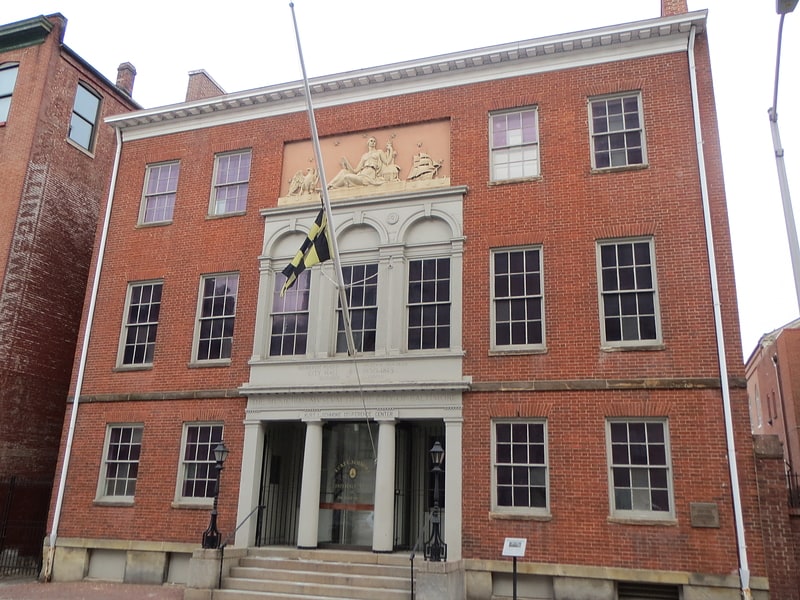
Museum in Baltimore, Maryland. The Peale Museum, officially the Municipal Museum of the City of Baltimore, was a museum of paintings and natural history, located in Baltimore, Maryland, United States. It occupied the first building in the Western Hemisphere to be designed and built specifically as a museum. The museum was imagined by American artist and inventor Rembrandt Peale and designed by architect Robert Cary Long, Sr. Much later, it functioned separately as Baltimore City's historical museum while the original structure was being rebuilt, restored, and renovated in 1930–1931, and then was merged with other historic sites, houses and museums in the early 1980s under the expansive efforts of a new executive director, with the name of the Baltimore City Life Museums and a broader mission in conjunction with the other historical locations/sites/structures in Baltimore.
After opening a new three-story exhibition gallery, uniquely using the old cast-iron façade of the razed (but placed in storage in a city yard for 30 years) Fava Fruit Company and being re-assembled on the new structure facing North Front Street and the parallel new President Street boulevard (between East Lombard and East Fayette streets), the new gallery and the B.C.L.M. ran into financial difficulties in the first year (1996–1997) after the grand opening, coincidentally during the bicentennial celebration of Baltimore's establishment as a city. The Peale branch of the City Life Museums closed with the other branches, historic houses and sites later in 1997, after being refused a one-year extension of its five-year subsidy of about $300,000 annually by then Mayor Kurt Schmoke. Its large collections from over 66 years of original existence were disassembled, transferred and handed over to the Maryland Center for History and Culture, founded 1844, now located on the city block on the southwest corner of West Monument Street and Park Avenue, centered in the old Enoch Pratt Mansion and adjacent research library and museum exhibition areas building. The building was designated a National Historic Landmark in 1965.
Today, the museum is being renovated and relaunched as the Peale Center for Baltimore History and Architecture through a partnership between Baltimore's Department of General Services, which owns the building, and the Board of the Peale Center for Baltimore History and Architecture, a 501(c)(3) tax-exempt, non-profit corporation. The building closed in 2019 for extensive interior renovations, but anticipates re-opening in 2022. In the meantime, the museum opened a virtual version of the 1814 building in the virtual world known as Second Life.[28]
Address: 225 Holliday St, 21202 Baltimore (Central Baltimore)
Babe's Dream
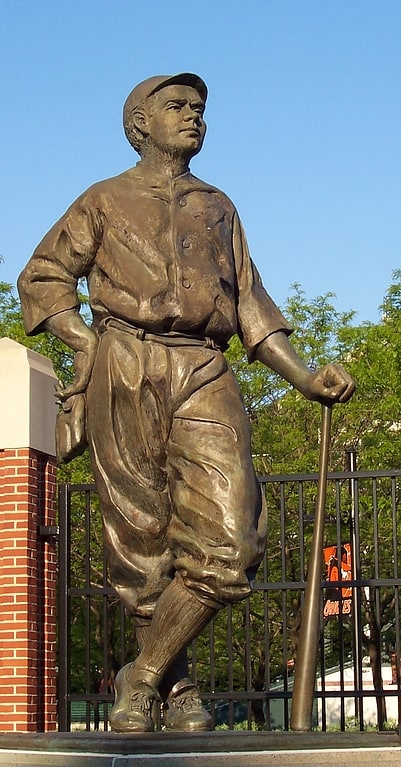
Statue by Susan Luery. Babe's Dream is a 1995 bronze statue of Babe Ruth, by Susan Luery. It is located at West Camden Street and South Eutaw Street, at Oriole Park at Camden Yards, Baltimore.
The statue contains an error in that Ruth is depicted with a right-handed fielder's glove, for wear on the left hand. Ruth threw left-handed.[29]
Baltimore City Hall
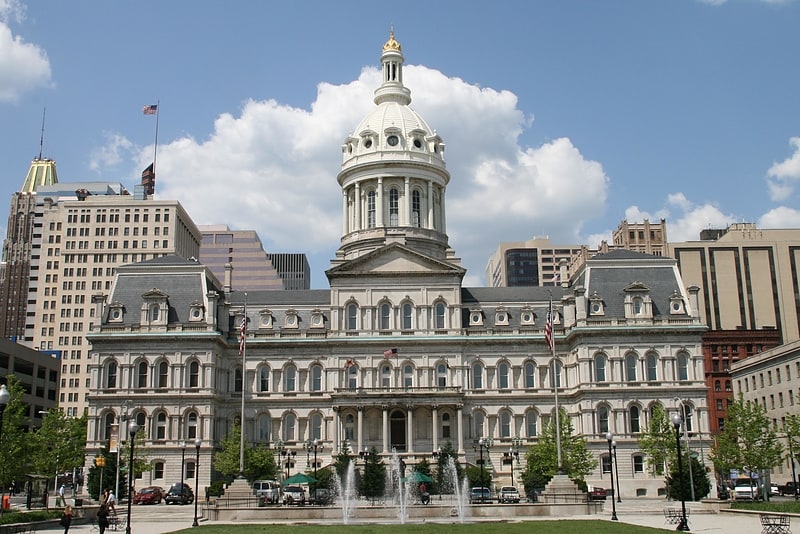
City government office in Baltimore, Maryland. Baltimore City Hall is the official seat of government of the City of Baltimore, in the State of Maryland. The City Hall houses the offices of the Mayor and those of the City Council of Baltimore. The building also hosts the city Comptroller, some various city departments, agencies and boards/commissions along with the historic chambers of the Baltimore City Council. Situated on a city block bounded by East Lexington Street on the north, Guilford Avenue on the west, East Fayette Street on the south and North Holliday Street with City Hall Plaza and the War Memorial Plaza to the east, the six-story structure was designed by the then 22-year-old new architect, George Aloysius Frederick in the Second Empire style, a Baroque revival, with prominent Mansard roofs with richly-framed dormers, and two floors of a repeating Serlian window motif over an urbanely rusticated basement.[30]
Address: 100 Holliday St Ste 250, Baltimore (Central Baltimore)
Historic Ships in Baltimore
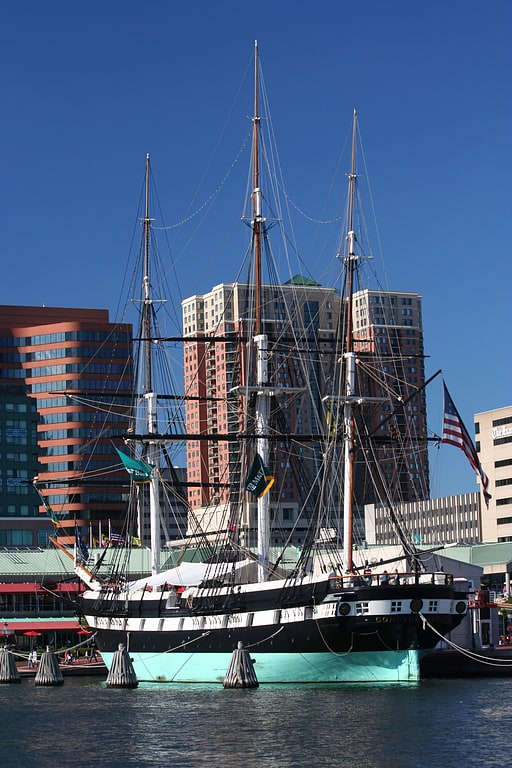
Museum. Historic Ships in Baltimore, created as a result of the merger of the USS Constellation Museum and the Baltimore Maritime Museum, is a maritime museum located in the Inner Harbor of Baltimore, Maryland in the United States.
The museum's collection includes four historic museum ships and one lighthouse:
- USS Constellation, a sloop-of-war
- WHEC-37, a Coast Guard cutter
- USS Torsk (SS-423), a World War II-era submarine
- Chesapeake (LV-116), a lightship
- Seven Foot Knoll Light, a screw-pile lighthouse
All are listed on the National Register of Historic Places. The three ships are also National Historic Landmarks.
The Liberty ship SS John W. Brown is also homeported out of Baltimore.
Historic Ships in Baltimore is an affiliate of the Living Classrooms Foundation.[31]
Address: 301 E Pratt St, 21202 Baltimore (Central Baltimore)
Baltimore Public Works Museum
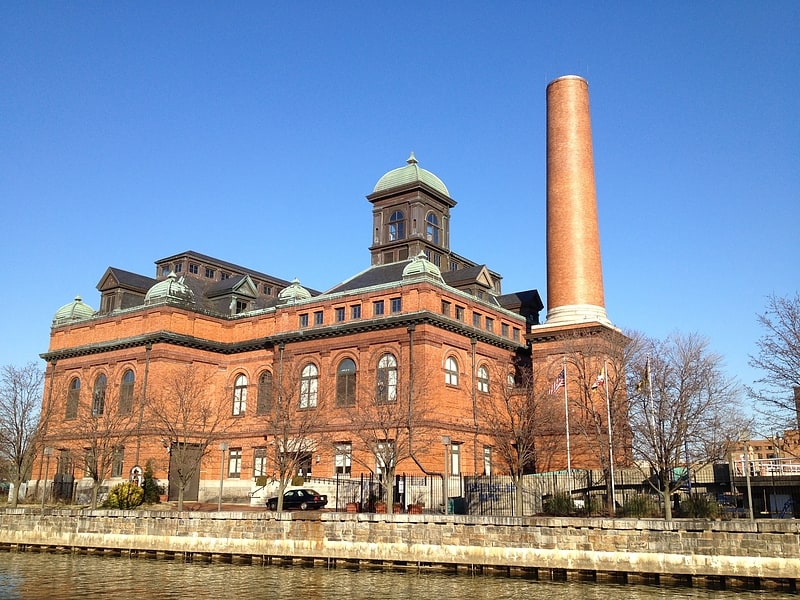
Museum in Baltimore, Maryland. The Baltimore Public Works Museum was located at 751 Eastern Avenue, Pier 7 of the Inner Harbor, Baltimore, Maryland. This museum provided a behind-the-scenes glimpse of how a large city provides public works utility services to its citizens. Exhibits also explained street lighting, road maintenance, and trash removal. An outdoor sculpture called Streetscape was an intricate model of a network of phone lines, street lights, storm drains and pipes for water, gas, and sewage disposal. The building housing this display is an operating sewage pumping station built in 1912.
The museum opened in 1982 and was operated under the auspices of the Baltimore Department of Public Works. On February 3, 2010, the city announced that the museum would close immediately due to budget constraints.
Since then, various efforts have been made to re-open the Baltimore Public Works Museum. Attendees of the centennial celebration event of the city's Montebello Water Filtration Plant in 2015 were given blue bags by the Baltimore City Department of Public Works that had printed on them www.PublicWorksMuseum.org, a website associated with a group called "Friends of the Public Works Museum" whose goal "is to reopen the Public Works Museum", though by 2017 that did not lead to a valid website. In 2016, the building was made a Baltimore City Landmark.
In 2018, a new effort was announced to renovate the facility and open an expanded museum called the "Public Works Experience".
The Public Works Experience Board of Directors is working to rejuvenate the museum into a hands-on, STEM-focused engagement to help visitors learn about the importance of public works. While the facility remains closed to the public, the Executive Director report the Board continues to plan strategies for eventual re-opening.[32]
Address: 751 Eastern Ave, Baltimore (Central Baltimore)
Cathedral of the Incarnation
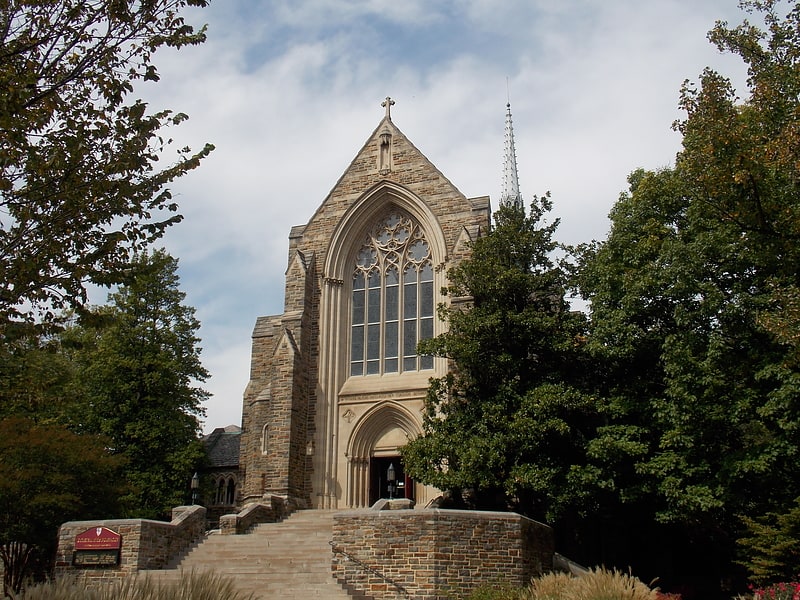
Cathedral in Baltimore, Maryland. The Cathedral of the Incarnation is an Episcopal cathedral in the Guilford neighborhood of Baltimore, Maryland, United States. It is the seat of the Diocese of Maryland.[33]
Address: 4 E University Pkwy, 21218 Baltimore (Northern Baltimore)
Westminster Hall and Burying Ground
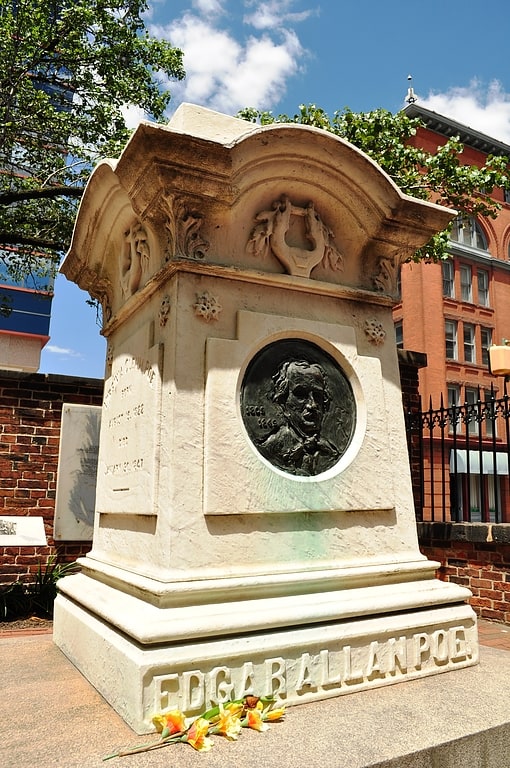
Graveyard. Westminster Hall and Burying Ground is a graveyard and former church located at 519 West Fayette Street in Baltimore, Maryland, United States. It occupies the southeast corner of West Fayette and North Greene Street on the west side of downtown Baltimore. It sits across from the Baltimore VA hospital and is the burial site of Edgar Allan Poe. The complex was declared a national historic district in 1974.[34]
Address: Fayette and Green Streets, 21201 Baltimore (Central Baltimore)
Baltimore Museum of Industry
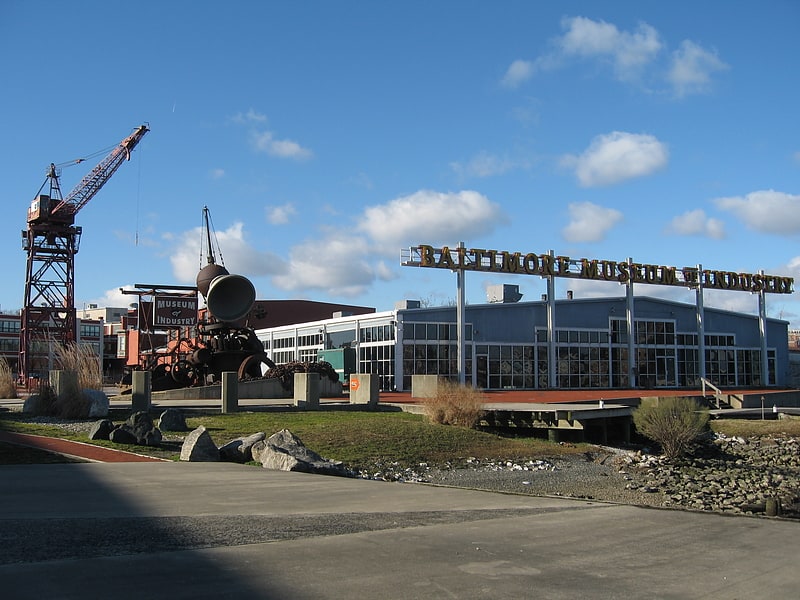
Museum in Baltimore, Maryland. Baltimore Museum of Industry is a museum in Baltimore, Maryland, United States. Located in an old cannery, the museum has exhibits on various types of manufacturing and industry from the early 20th century. There are several hands-on sections with working equipment and other artifacts.[35]
Address: 1415 Key Hwy, 21230 Baltimore (Central Baltimore)